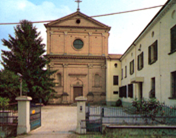
Byzantine icon at the Cloistered Visitation Nuns in Treviso
There is a Byzantine icon of obscure origins, but certainly very distant in time, inside a monastery on the outskirts of Treviso, a few steps from one of the busiest arteries that skirt the city. It is a high relief image on plane tree wood, called “Beata Vergine della Cintura”, returned to Treviso after a loan to the diocesan museum of Santa Apollonia, in Venice, and which the public can now admire more easily ‘ given that the cloistered nuns of the Visitation order, who manage the structure, have decided to open the doors of some rooms.
The monastery, built on the eve of the Great War, is today the home for 23 nuns who guard, among other relics, the heart of Saint Francis de Sales, patron saint of journalists and, above all, founder of the order, in 17/ th century, in France, together with Saint Jane Frances de Chantal.
The nuns, over the centuries, due to migrations due to the political instability of the transalpine region, have progressively moved to Northern Italy, finding a favorable place to stay in Treviso in the last century. Until the mid-twentieth century their presence was much more massive than today, and the resources obtained from breeding and cultivating the small adjoining farm were still sufficient for their sustenance and assistance to those in need.
In the following decades the convent slowly emptied due to the progressive decline in vocations but the environment still maintains the strong silent charm of a place of deep meditation and prayer.
The “Blessed Virgin of the Belt” has a dubious dating and its location is judged, depending on the scholars consulted, to be within a span of approximately four centuries around the year 1000. Also exhibited together with the work is the sarcophagus inside which, since its departure from Byzantium, perhaps more than a millennium ago, the high relief was transported across European countries.
Even today the nuns maintain small work traditions, such as the production of nativity scenes, embroidered garments and baked sweets to sell to external visitors or to offer those looking for a few days of quiet inside the rooms made available, as in the past, to travellers. and pilgrims.
Source: Icona Bizantina presso le Monache di Clausura a Treviso – Marcadoc